LEDdynamics’ PERFEKTLIGHT™ Technology Tunes & Corrects White Light
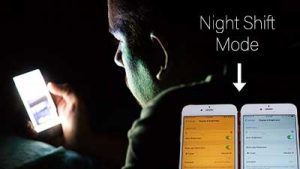 The popularity of tunable white LED lighting is a lasting trend. Aside from its obvious improvements for lighting options, it also stands to make a positive impact on our overall health and well-being. Specifically, studies on Circadian Rhythm are proving how important the timing of specific correlated color temperatures (CCT) are during a daily cycle, from aiding hormone release, influencing digestion, maintaining body temperature, supporting healthy sleep patterns, and other key bodily functions.
The popularity of tunable white LED lighting is a lasting trend. Aside from its obvious improvements for lighting options, it also stands to make a positive impact on our overall health and well-being. Specifically, studies on Circadian Rhythm are proving how important the timing of specific correlated color temperatures (CCT) are during a daily cycle, from aiding hormone release, influencing digestion, maintaining body temperature, supporting healthy sleep patterns, and other key bodily functions.
This technology has already found its way into smartphones, tablets, and computers. For instance, Apple and Android have implemented a night shift mode from sunset to sunrise. This mode allows the phone’s screen to mute a lot of its blue tones throughout the evening and early morning.
This reliance on artificial light has not always been typical.
Over the past three hundred thousand years, humans have evolved under natural daylight. Waking up in the morning and seeing that warm (2,700K) sunrise and 6,500K (cool-white) as the day progresses towards noon, where CCT peaks. As time moves towards the afternoon and evening, the color temperature decreases back down to around 2,700K again (illustrated in the daily sunlight cycle pictured below).
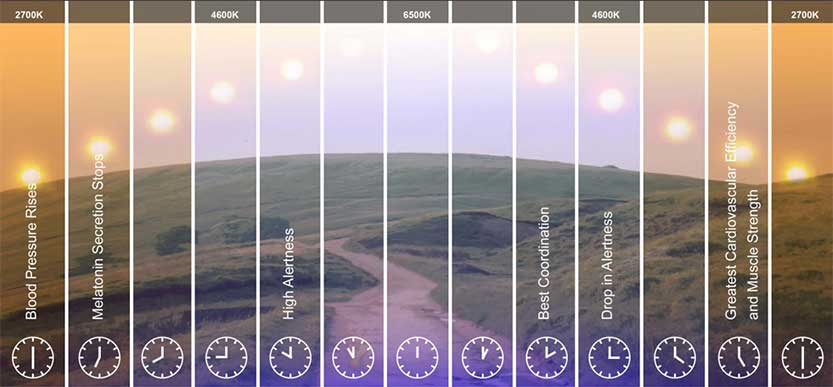
This color shift is the result of the sunlight traveling through more of the earth’s atmosphere in the morning and evening, which causes the blue light to scatter. This is why we see those nice reds and oranges seen through sunrise and sunset. The blue light is not as scattered because it travels through less of the earth’s atmosphere in the middle of day, producing a higher “bluish” color temperature.
PERFEKTLIGHT can replicate this change automatically with “PERFEKT” CCT.
Comparatively, it has been a fairly short period of time that humans have been living and working under artificial illumination. Figure A and B, in the image below is a spectral power distribution graph of sunlight. It is a pretty good representation of light from all the visible spectrums. As you can see, sunrise and sunset have very muted violets, blues, and greens and a lot of reds and red-oranges.
Incandescent bulbs, figure D, are a good representation of sunrise and sunset but do a poor job matching sunlight CCT throughout the remaining parts of the day.
Additionally, the LED bulbs do not match any of the spectral graphs. Figure C graphs a typical 5,000K (cool-white) 80min Color Rendering Index (CRI) part that is prevalent in many of the products available in the marketplace today. The large blue spike has significant consequences for tunable white LED systems trying to produce circadian lighting.

Figures A, B, C & D from Left-to-Right
PERFEKTLIGHT is very different from all other light sources.
Pictured below is the spectral distribution of PERFEKTLIGHT. At 2,700K, it has muted blues and lots of the reds, red orange, and ambers typically experienced in the sunlight. As the color temperature increases on the diagram, traveling from the left-hand side to the right-hand side, the blue increases. PERFEKTLIGHT at about 6,500K is almost an exact spectral distribution match of sunlight; there is a nice even balance of blues all the way up to the reds..
Artificial sunlight with LEDs is made possible with the latest Nichia LED technology and LEDynamics patent pending PEFEKTLIGHT technology. CRI is typically 95 or greater and CCT is directly on the Blackbody line (BBL).
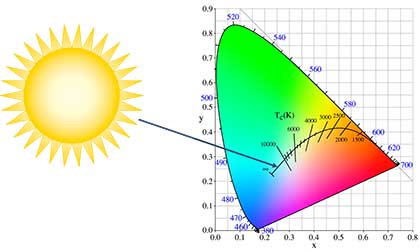
Blackbody Line or Plankian Locus
The Blackbody line (BBL) is based on the color a dark iron metal typically glows when heated up to that temperature. When you heat a chunk of iron up to 2,700K, it glows that nice red-orange and amber color, seen from incandescent bulbs. As this chunk of iron gets hotter the color temperature goes from that red-orange and amber, up to a neutral-white. As it continues up to 6500k, the bluish-white tone shows-up.
This is relevant because LED binning is defined around the BBL. In figure E below, the BBL has ANSI-defined boxes; ANSI is defined by eight color bands. Within those ANSI defined boxes there can be roughly five-step MacAdam ellipse and smaller three-step MacAdam ellipse. LED manufacturers are doing their best to put LEDs right on the BBL. In some instances, two steps are available and in rare cases, some LED manufacturers can even produce one step.
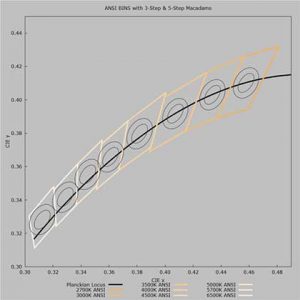
Figure E – ANSI & MacAdam Ellipse on Blackbody Curve
Typical tunable white LED systems mix two LEDs with opposite color temperatures. In the graph below you can see a 2,700K LED in the upper right and a 6,500K LED in the lower left. The 2,700K LED measures in at about a three-step MacAdam ellipse. On the other hand, the 6,500K LED, even though it is a three-step part, turned out to be right on the BBL.
Tuning between the two colors creates CCT in a straight light between the two LEDs; illustrated by the purple line in Figure F below. The hue error is between the purple line and the BBL. In the middle of that straight line is where the delta between the BBL is the greatest. The hue error around 4,000K is outside of the seventh step MacAdam ellipse. Anybody looking at that would be able to tell there is something not quite right with that lighting.
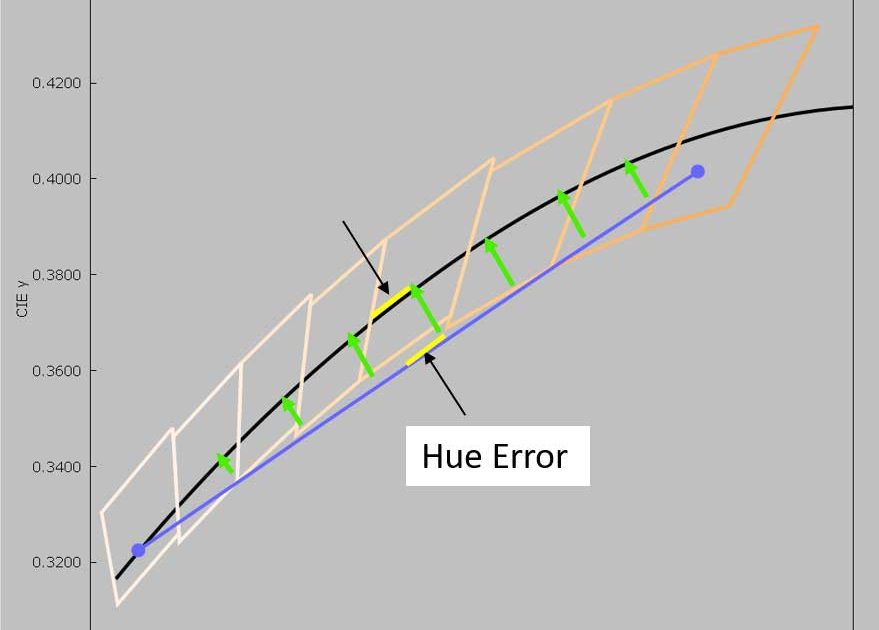
Figure F – Illustrating Hue Error without PERFEKTLIGHT correction
This is what PERFEKTLIGHT corrects!
Zachary Treamer, LEDdynamics Director of Product Marketing says, “PERFEKTLIGHT™ technology, recognized by the IES 2020 progress report, color corrects tunable white light; eliminating hue error seen when tuning from warm correlated color temperate (CCT) to cool. Its patent-pending hue correction technology conveniently pairs with “set-it & forget-it” controls to mimic sunlight CCT & CRI from sunrise to sunset and maintain even light across the whole CCT range. Lux or foot candles measured on a surface at 2,700K are going to be the same as 6,500K (Figure G).”

Figure G – PERFEKTLIGHT Maintains Even Light Across the Whole CCT Range
The green line on the graph below shows the CCT with the PERFEKTLIGHT correction.


Figure H
Treamer continues, “PERFEKTLIGHT corrects that hue error by filling the External Quantom Efficiency green gap (Figure H). PERFEKTLIGHT is able to correct that hue error as the white is tuned along the whole CCT; keeping the light CCT directly on the BBL as desired.”
LEDdynamics CEO, Neil Cannon, adds “Tunable white had long-standing issues. Our aim with PERFEKTLIGHT was not to get close to sunlight, but to exactly match it. Now, sunlight can be brought indoors with controls to synchronize the interior lighting with what is happening outside throughout the day. This has the added benefit of minimizing the disruption to our circadian rhythm.”
Prolume did the first installation of PERFEKTLIGHT in Randolph, VT at Chefs Market. LEDdynamics designed LED modules to retrofit their pendant style light fixtures. There is a great picture below, showing the historic building that has been renovated into an organic grocer as well as a fantastic restaurant.
The pictures show the retrofitted pendants, and if you look closely, there are three pendants in the center picture. If you draw your attention to the pendant in front of one of the many windows (we recommend the one furthest way), it shows how the color temperature of the light coming into the window and the color temperature of the pendant are perfectly matched.
The feedback received from the owners of Chef’s Market, as well as the employees and the community, has been overwhelmingly positive. The owners report the lighting has caused an increase in sales as more consumers wish to be there, and even employees say they are feeling more energized at work and able to fall asleep better in the evening.

PERFEKTLIGHT is the ideal solution for Human Centric Lighting and the health lighting market.
LEDdynamics will provide the highest possible quality of light using the latest technology, in the hopes that by bringing the outside lighting to the indoors, the disruption to circadian rhythms will be decreased. As science has proven, this will have the added benefit of enhancing sleep cycle and other necessary health impacts on the body.
Studies have shown that adjusting the color temperature at various points in the day for students at school also enhances their productivity, a realization that can be extrapolated to enhancing productivity for any artificial illuminated environment.
The schedule is set by a real-time clock with “set-it and forget-it” electronics, which allow the whole system to integrate with the existing controls. It does not require any sophisticated set-up. The real-time clock and “set-it and forget-it” control electronics make it work outside of the box. PERFEKTLIGHT is also compatible with third-party controls if required.
When PERFEKTLIGHT was first theorized by LEDdynamics CTO, William McGrath, it struck excitement amongst the team. “Only after testing the hypothesis did the excitement turn into a reality for us,” said Mr. McGrath. “In some cases, seeing is believing. This is one of those cases,” McGrath, concluded.
A portable PERFEKTLIGHT demonstration kit is available. LEDdynamics sales team would love the opportunity to present this technology further. Please take a look at the main PERFEKTLIGHT webpage for more info or contact us beleow:
Please contact us about PERFEKTLIGHT.

